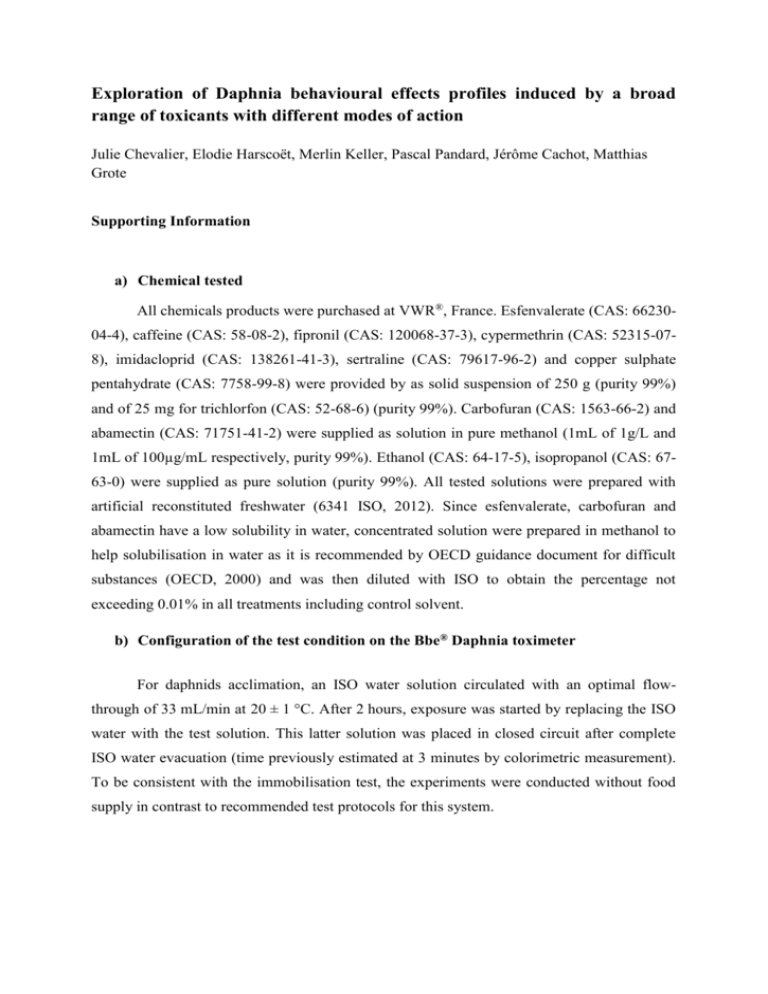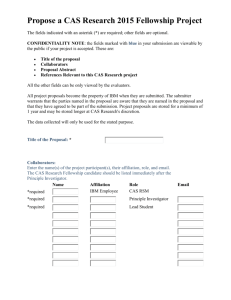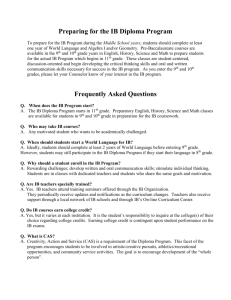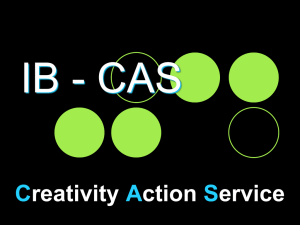etc2979-sup-0001-SuppData
advertisement

Exploration of Daphnia behavioural effects profiles induced by a broad range of toxicants with different modes of action Julie Chevalier, Elodie Harscoët, Merlin Keller, Pascal Pandard, Jérôme Cachot, Matthias Grote Supporting Information a) Chemical tested All chemicals products were purchased at VWR®, France. Esfenvalerate (CAS: 6623004-4), caffeine (CAS: 58-08-2), fipronil (CAS: 120068-37-3), cypermethrin (CAS: 52315-078), imidacloprid (CAS: 138261-41-3), sertraline (CAS: 79617-96-2) and copper sulphate pentahydrate (CAS: 7758-99-8) were provided by as solid suspension of 250 g (purity 99%) and of 25 mg for trichlorfon (CAS: 52-68-6) (purity 99%). Carbofuran (CAS: 1563-66-2) and abamectin (CAS: 71751-41-2) were supplied as solution in pure methanol (1mL of 1g/L and 1mL of 100µg/mL respectively, purity 99%). Ethanol (CAS: 64-17-5), isopropanol (CAS: 6763-0) were supplied as pure solution (purity 99%). All tested solutions were prepared with artificial reconstituted freshwater (6341 ISO, 2012). Since esfenvalerate, carbofuran and abamectin have a low solubility in water, concentrated solution were prepared in methanol to help solubilisation in water as it is recommended by OECD guidance document for difficult substances (OECD, 2000) and was then diluted with ISO to obtain the percentage not exceeding 0.01% in all treatments including control solvent. b) Configuration of the test condition on the Bbe® Daphnia toximeter For daphnids acclimation, an ISO water solution circulated with an optimal flowthrough of 33 mL/min at 20 ± 1 °C. After 2 hours, exposure was started by replacing the ISO water with the test solution. This latter solution was placed in closed circuit after complete ISO water evacuation (time previously estimated at 3 minutes by colorimetric measurement). To be consistent with the immobilisation test, the experiments were conducted without food supply in contrast to recommended test protocols for this system. c) Average swimming speed ± standard error (per hour) of Daphnia magna neonates exposed to several concentrations of (A) isopropanol (B) ethanol (C) copper sulphate (D) trichlorfon (E) esfenvalerate (F) fipronil (G) sertraline (H) cypermethrin (I) caffeine (J) abamectin (K) carbofuran and (L) imidacloprid for 48 hours in the “MultiDaphTrack” system. 7 (A) 6 5 4 3 2 1 0 0 10 20 30 40 50 7 (B) average speed (mm/s) 6 5 4 3 2 1 0 0 10 20 30 40 50 7 (C) 6 5 4 3 2 1 0 0 10 20 30 Time (hours) 40 50 4 (D) 3 2 1 0 0 10 20 30 40 50 7 average speed (mm/s) (E) 6 5 4 3 2 1 0 0 10 20 30 40 50 4 (F) 3 2 1 0 0 10 20 30 Time (hours) 40 50 5 (G) 4 3 2 1 0 0 10 20 30 40 50 7 (H) average speed (mm/s) 6 5 4 3 2 1 0 0 10 20 30 40 50 5 (I) 4 3 2 1 0 0 10 20 30 Time (hours) 40 50 4 (J) 3 2 1 0 0 10 20 30 40 50 4 average speed (mm/s) (K) 3 2 1 0 0 10 20 30 40 50 4 (L) 3 2 1 0 0 10 20 30 40 - – – – - – 50 Time (hours) Controls below EC5 near EC10 near EC20 EC50-EC70 >EC70 d) Daphnia magna chronic toxicity data from literature and on-line database compared to the behavioral LOECs obtained from the “Multi-DaphTrack” system. (a: (USEPA 2014), b: (Jemec et al. 2007), c: (Minagh et al. 2009), d: (Muyssen and Janssen 2007), e: (Firpo 2011), f: (Matsumoto 2009)). Substance Chronic test Behavioral test LOECs (mg/L) NOECs (mg/L) LOECs (mg/L) Isopropanol <1300 N.D. N.D. Ethanol 4800 16a 0.01a Caffeine 25 N.D. N.D. Imidacloprid 85 1.5b 2.5b Sertraline 0.03 0.032c 0.1c Copper sulfate <0.028 0.075d 0.09a Fipronil <0.001 0.010a 0.019a Carbofuran <0.011 0.01a 0.027a Esfenvalerate <0.0001 0.00011e N.D. Cypermethrin 0.00004 0.0000009a 0.000002a Abamectin <0.00004 0.00003a 0.00009a Trichlorfon 0.00034 0.000006a 0.001f









